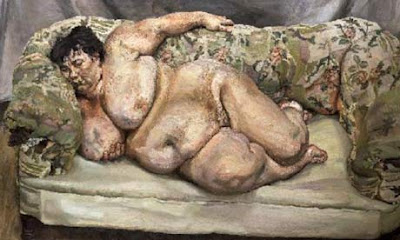
© Royal Academy of Arts The Road Across the Wolds, 1997
Hockney shows a plethora of work abundant in highly vivid colour and rich in imagery but all devoted to one genre- landscape. He crosses boundaries with experimentation in scale and medium with an enormously vast room devoted to his newly acquired passion for ipad paintings, of which I remain somewhat unconvinced by being a bit of a luddite in my views towards technology. Despite previously being inspired to capture the culture and allure of distant destinations (such as L.A. swimming pools!), there is something quite profound and comforting of his choice to return and draw the landscape within 65 miles of where he was born in Bradford. Aesthetically pleasing and not at all very emotional challenging, we are drawn from room to room in what seems like an endless attack of colour and nature.

© Royal Academy of Arts The Arrival of Spring in Woldgate, East Yorkshire in 2011 In my opinion, although I can recognize that the ipad is just being used as another drawing tool, like a paintbrush or a pencil, I find it gives the images a rather flat, lifeless quality with their lack of texture.
Freud's retrospective of work show the development and progression of his painting in terms of subject and style. What’s consistent throughout is his ability to succeed in capturing the soul of the sitter, albeit with a rather more often than not melancholic essence. His paintings have a darker, deeper aesthetic with the sitter often placed in a rather grim, basic looking setting. Freud's figures are often rather androgynous and unconventional looking. He does not beautify his subjects but instead presents to us the unadulterated truth through his depiction of lived-in, pasty skinned bodies. As we are guided around the exhibition, what becomes clear is the documentative quality of his paintings. Rather like visual diaries, they record and portray changing emotions towards his wives and lovers and poignantly his difficult relationship with his mother. Some are astoundingly amorous and affectionate whilst others clearly painted with animosity and bitterness towards a subject or situation and in order to intensify this he often paints his subject within empty, dilapidated rooms. One which particularly springs to mind is that of Freud and his then wife in a hotel room. Whilst she lies alone in bed with an extremely pained facial expression and nervous composure he is seen hovering in the dark shadows of the background. Through the window, the roofs of Paris taunt like an unreachable haven. Whether you appreciate the paintings for their metaphoric qualities and emotional complexity or merely their aesthetic exquisiteness with patchwork strokes composing admirable detail and finesse, I highly recommend that you go and see this exhibition.

Girl With A White Dog (1950-1951) - A rather harrowing portrait of his first wife Kitty shortly before they separated.

Benefits supervisor sleeping. Courtesy of National Portrait Gallery.
The work of both artists is equally highly accomplished and inspirational. Hockney’s love for Yorkshire radiates from his colour crammed countryside compositions- which mum and I decided was a fabulous free promotion for the Yorkshire Tourist Board. While what Freud’s lacked in colour they made up for in raw emotion and human energy. On thing is guaranteed, the sales of paintbrushes are bound to be on the increase. I challenge anyone not to be inspired!

No comments:
Post a Comment